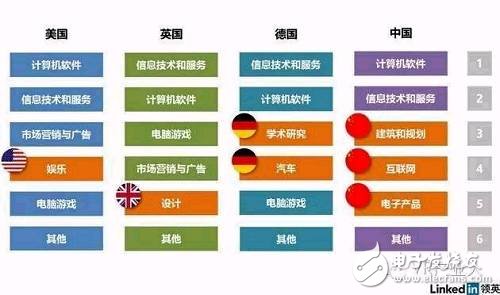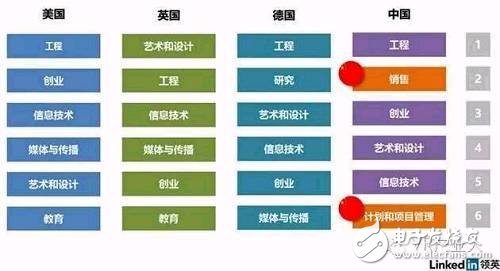Recently, the global VR (Virtual Reality) talent report released by LinkedIn, the global workplace social platform, has attracted many media reprints. In this report, LinkedIn disclosed a lot of interesting data.
Analysis of geographical distribution of global VR practitioners

The data shows that the US VR talents account for 40% of the global total, while the number of Chinese VR talents accounts for 2% of the world, which is lower than India. From the perspective of VR job demand, the United States has nearly half of the total, while China accounts for about 18%.
As can be seen from the above figure, 40% of the current global VR practitioners are located in the United States, and the second place is the United Kingdom, 9%. Canada, France and India accounted for 4-5% respectively, while China accounted for only 2%. The author believes that this figure basically reflects the current world's top technology.
The founder of VR, who has a British experience, told the author that due to the good commercial capital environment in the United States, many scientists, including Europe, have chosen to start businesses in the United States (which is why cutting-edge technology companies often originate in the United States). Then, when the scientists are older, some will choose to return to European universities, especially Oxford and Cambridge in the UK, so the education level in European universities is very high.
As for China, which only accounts for 2%, some people, especially research institutes, have quite a few words. However, the problem of the lack of technical talents in domestic VR enterprises is indeed widespread, and even serious enough to affect the degree of enterprise development. Even if the actual ratio is higher than this, it is not much higher.
Why are the global VR talents entangled?

Among the three countries with the most concentrated VR talents in the world, VR talents in the United States are mostly in the old IT giants such as Google, Microsoft, Intel, and well-known VR startups such as Oculus and MagicLeap. Most of the UK and Canada are concentrated in higher education institutions and research institutions, leading the basic research and innovation of VR technology (this is also consistent with the information mentioned above).
In fact, there are two main factors in the phenomenon of high-tech talents:
1. Capital attraction
Talent is first and foremost a person, and the same is true. Therefore, high compensation is one of the prerequisites. Therefore, only large companies or companies that have invested heavily can recruit better talents. In the past six months, in addition to the above-mentioned enterprises, large companies including Apple and Huawei have begun to recruit high-end talents and even directly absorb high-tech enterprises through acquisition.
2. Leading aura
Technical talents chase money, just to give themselves, and more importantly, to give the family a guarantee. In fact, this group pays more attention to the study and progress of technology. If a leading figure of the same industry is in a company, it is easy to attract more talents to gather around, and even some people are willing to pay a salary increase. In the field of VR, this law also exists. Once a leading figure in a certain aspect joins a company, it will inevitably lead more talents to join. (Domestic companies complain to me: I have hired a Ph.D. in VR. I don’t see more talents joining me!! My reply is: Where does this doctor come from? After all, even if it is abroad, there are only a few universities. Relevant majors can be recognized.)
So in these decades, we found an interesting phenomenon: technology companies such as Microsoft and Google tend to absorb a large number of talents, and more and more, and then more and more results, and then build a benign cycle. In contrast, most companies are in a situation of “no one is using, hard to useâ€, especially in this VR wave, the domestic VR technology talent gap is huge.
Talent function focus direction comparison

According to LinkedIn's statistics, China's VR talents are indeed quite different from those of European and American countries. Apart from "computer software" and "information technology and services," there are other buildings and plans that China has no or lack of. "Internet" and "electronic products" talents are less "computer games" talents (Tucao: Since statistics have Internet talents, then the proportion of Chinese talents is not only 2%?!). 
On the other hand, there are statistics on the talent function. As can be seen from the above figure, “engineeringâ€, “entrepreneurshipâ€, “information technologyâ€, “media and communicationâ€, “art and design†and “education†are the top talents. In addition, China has “sales†talents and ranks high. (Can't help but vomit one sentence: What kind of VR talent is sales?)
Statistics are for reference only
In fact, this statistic is for reference only. One reason is the definition of VR talent. The disciplines involved in VR are increasingly widespread, and related companies and talents have not been counted. The previous geographical and attribution statistics seem to indicate that VR talents are technology-oriented, but functional statistics show that the definition of talents is still very broad, and even includes "marketing and advertising", "cars", "entertainment", "sales", and "media." And communication, etc., but some basic discipline talents, such as "graphic image", "optical", "chip", "operating system" and even popular "SLAM algorithm", "location tracking", "human-computer interaction", etc., are not listed. In.
On the other hand, LinkedIn is a global workplace platform. Many domestic and foreign scientific research personnel are not logged into the website, so they will not be counted.
Obviously:
This talent statistic is general and not refined to an authoritative level.
The domestic status reflected is true
Through this statistical report, more people have seen the current problems in terms of talents in China, such as “lack of high quality and professional talentsâ€, “the lack of industrial ecosystems, lack of talents in key linksâ€, and “the demand for talents is very urgent†( The illustration shows that China's demand for talents ranks second in the world. The author's feeling is that the ranking is not the first. However, the current domestic VR market is not in the demand for talents, and the company is pursuing more content. Talent).

At present, some institutions, enterprises, and institutions have promoted the cultivation of local talents, but mainly focused on software. The real most missing talents can only rely on bringing in cutting-edge talents and technology from overseas, but how easy is it? !
It seems that the practical measures are nothing more than the following:
1. High-level technical core in high-paying recruitment;
2. Huge investment and acquisition of core technology companies (Twitter just bought Magic Pony for $150 million);
3. Pay a high technical license fee;
4. Crack, learn, crack...
5. Focus on application-level R&D;
6. Give play to the advantages of market scale and gradually realize the localization of technology;
7. Cultivate core technical talents (long-term goals).
In short, VR is a long-term business that cannot be accomplished overnight. The current talent dilemma is just beginning.
DXZPET tinned copper braided sleeve /tinned copper braided belt/copper braided wire
Tinned copper Braided Sleeve/ tinned copper braided belt/ copper braided wire, is braided by multi-strand (example: 13s, 16s, 24s, 36s, 40s, 48s, 64s, 96s) high quality round copper wire or tinned soft round copper wire with the way of single layer or multilayer.
The outer diameter size of the copper wire: 0.1mm, 0.12mm, 0.15mm, 0.20mm. The DC resistance ( 20℃ )of copper braided wire is not more than 0.22 Ωmm2 /m , the DC resistance ( 20℃ )of tinned copper braided wire is not more than 0.0234Ω mm2 /m .
DXQZ- tin plated copper light weight shielding braided is made by specific copper wires which are braided refinedly, product has the advantages of
shielding to electromagnetic signal, light weight, good flexibility and others, it can reduce the total weight of finished products compared with tin plated copper braided sleeves.
ST-PB Velcro Shielding Sleeving is made by the composite of tinned copper hook wire, fire retardant cloth and magic tape, has the e
ffects of shielding high sensitive electromagnetic interference, reducing noise, dust prevention and earth leakage protection. Velcro Shielding Sleeve is widely used in railway vehicle, high-speed rail, automotive, aerospace, communication, industrial machinery, medical equipment, electronic appliances and oth1r fields.
OAF- Aluminum foil Fiberglass Heat Reflective Sleeving (Aluminum foil fiberglass tube)is made of two layers, Aluminum foil fiberglass sleeve the inner is weave by glass fiber yarn, the outer layer cover a layer aluminum foil. Due to the use of special processing, the product good shading, reflecting heat, insulating heat, shielding signal, resistance to high-low temperature and other good characteristics.
ZIP-PB Zipper Design EMI Shielding Sleeving is made of the recombination of tinned copper hook silk net,flame retardant cloth and zipper. Zipper EMI Shielding Sleeve Has the characteristics of shielding High sensitive electromagnetic interference, noise-reduction, dust proof and abrasion resistance.With the zipper design,Zipper Shielding tube easy for installation and removal, convenient to use.
PNBT -metal shielding open-type densely woven protective sleeve , this shielding braided sleeve has excellent shielding, opening structure, easy to install, overhaul, and reusable. Metal braided sleeve widely used for anti-interference shielding protection of electronic, electrical and mechanical, railway, automotive wiring harness, optical fiber communication, aerospace wiring harness signals.
Tinned copper shield braided sleve,Electromagnetic information shielding braided sleeve,Very light shield braided sleeve,Aluminum foil fiberglass tube,Velcro shielding sleeve,Zipper shielding sleeve,Metal braided sleeve
KEYUACE Materials Co., Ltd. , https://www.insulationtubing.com